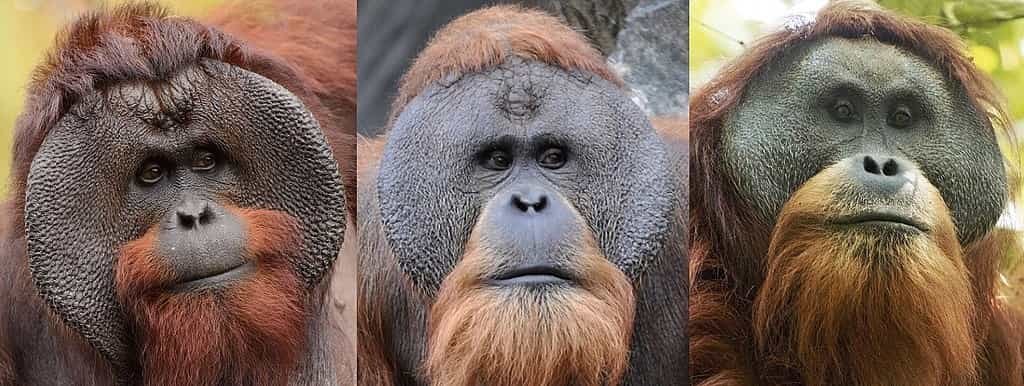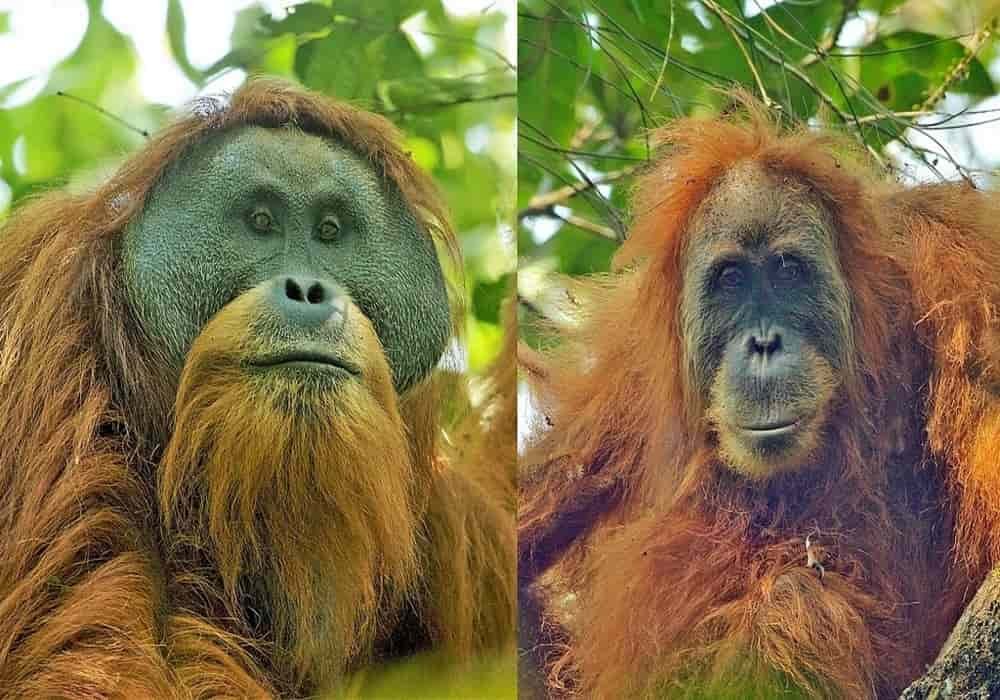Orangutan the largest arboreal mammal (which lives on trees)
Orangutan is a primate genus in the family of great apes (hominids), that is about ²/₃ as large as the gorilla and has brown skin, long sparse reddish-brown hair, and very long arms. The name “orangutan” comes from the Indonesian and Malay word “orang hutan“, which literally means “forest man”. These great apes have taken up residence in the treetops and tirelessly roam the canopy in search of fruit, leaves and insects.
There are three species: the Sumatran orangutan, the Bornean orangutan and the Batang Toru (Tapanuli) orangutan, endemic to a forest in North Sumatra, formally identified in 2017. In the three species the most males are larger than females and develop a large facial disc as they age.

HABITAT & DISTRIBUTION
Jungles of Malaysia (northern part of the island of Borneo) and the Indonesian island of Sumatra in Southeast Asia.
WEIGHT HEIGHT
Males can measure up to 1.40m in height and 2m in wingspan for a weight over 90kg, and females reach 1.15m for a weight of up to 50kg.
REPRODUCTION
After mating and a gestation of 9 months, the female gives birth to a single baby that she will accompany and educate for several years (from 6 to 10 years!), The orangutan being one of the animals in which the little one spends the most time with his mother. Births are rare because they are very spaced in time.
LONGEVITY
25 to 35 years old.
DIET
Omnivorous: fruits, plants, honey, eggs, insects, lizards and birds.
SAVED STATUS
Conservation Status in the Wild: Critically Endangered

Most of their native jungle disappears in favor of the monoculture of palm oil. Although it is protected, it is also poached or the young are sold as pets. Only 54,000 Borneo orangutans are believed to remain in the wild, just under 14,000 individuals for the Sumatran species and only 800 Tapanuli orangutans, the 3rd species formally identified in a single Sumatran forest in 2017.
3 main types of Orangutan
The orangutan is a large tree ape of the hominid family. Peaceful, intelligent and a keen observer of his surroundings, the native populations even say of him that he does not speak because he is too wise for that. There are three species: the Sumatran orangutan, the Bornean orangutan and the Batang Toru orangutan, endemic to a forest in North Sumatra, formally identified in 2017.
1. Bornean orangutan
The Bornean orangutan (Pongo pygmaeus) is a great ape. Together with the Sumatran orangutan and the Tapanuli orangutan described in 2017, it forms the genus of orangutans. It is endemic to Borneo (the island is half belong to Malaysia and half to Indonesia).
Bornean orangutans share with their Sumatran relatives a physique adapted to a tree-dwelling way of life: the arms are very long, the hands hook-shaped, the thumb short and located close to the wrist, the legs short and flexible and the feet hand-like. However, they are a bit sturdier and heavier than the Sumatran orangutans. Further differences lie in the longer fur, which is darker and more brown in color, and in the cheek bulges, especially of the older males: These grow outward and are almost hairless. In addition, the beard is usually shorter and the throat pouch larger in the older males. With up to 90 kilograms, the males are significantly heavier than the females, which can reach up to 50 kilograms (110 lbs).
Read also: Dugong (Duyung) | Herbivorous Marine Mammals With Amazing Bodies
Borneo orangutans are diurnal forest inhabitants; when they sleep they build a nest of leaves that is usually only used once. They slowly climb with all four limbs or swing on the branches. Males in particular also make forays on the ground – significantly more than their Sumatran relatives, which could be due to the lack of tigers on Borneo.
They are mostly found alone and more solitary than Sumatran orangutans. Males and females try to establish fixed territories, but younger animals in particular spend their lives as “hikers” who constantly roam without territory. They use tools much less frequently than their Sumatran relatives.
Borneo orangutans are herbivores that feed primarily on fruits, but also on leaves, young shoots and tree bark.
2. Sumatran orangutan
The Sumatran orangutan (Pongo abelii) is a great ape. Together with the Bornean orangutan and the Tapanuli orangutan described in 2017, it forms the genus of orangutans. They lives in the northwestern parts of the island of Sumatra (Indonesia).
The Sumatran orangutan got its scientific name after the British naturalist and botanist Clarke Abel.
Sumatran orangutans differ from their Bornean relatives, among other things, in their fur , which is usually lighter and more reddish in color and has a slightly more delicate, lighter build. The cheek bulges, especially of the older males, are somewhat smaller, they lie flatter on the head and are often covered with white hair. The beard worn by both sexes is usually a little longer, while the throat pouch of adult males is smaller. With the Bornean orangutans, they share a physique that has been adapted to a tree-dwelling way of life: the arms are very long, the hands are hook-shaped, the thumb is short and located close to the wrist, the legs are short and very flexible and the feet are hand-like.
Sumatran orangutans are diurnal forest dwellers, when they sleep they build a leaf nest that is usually only used once. They slowly climb with all four limbs or swing on the branches. In contrast to their Bornean relatives, they rarely come to the ground, presumably because of the threat from their main predator, the Sumatran tiger .
They are mostly to be found alone, but do not lead a strictly solitary way of life. Males and females try to establish fixed territories, with the male’s territory overlapping that of several females. They are more social than Bornean orangutans, sometimes two females join forces for several days to forage. There are observations of larger groups of this type and also temporary associations of a male with a female and their young. Younger animals in particular cannot establish a territory, but spend their lives as “hikers” who constantly roam around without a territory.
Presumably because of their more social way of life, they use tools much more frequently than their Bornean relatives. Animals have been seen using wooden sticks to dig, fight, or scratch themselves with. They protect themselves from rain and blazing sun with large leaves that they hold above their heads.
Sumatran orangutans are predominantly herbivores that feed mainly on fruits (such as figs ), but also on leaves, young shoots and tree bark. To a greater extent than Bornean orangutans, however, they also consume insects and other carnal foods. For example, there is evidence of the looting and consumption of Sunda slow loris.
3. Tapanuli (Batang Toru) Orangutan
The Tapanuli Orangutan (Pongo tapanuliensis) is a great ape. Together with the Sumatran orangutan and the Bornean orangutan , it forms the genus of orangutans. Phenotypically, it differs from the other Sumatran orangutans mainly through its head shape. The species lives in a narrowly limited range that includes a forest area south of Lake Toba on the island of Sumatra. Originally the population there was assigned to the Sumatran orangutan, but a study from 2017 gave it its own species status.
The Tapanuli orangutan resembles the Sumatran orangutan (Pongo abelii) more closely than the Bornean orangutan (Pongo pygmaeus) in its body shape and cinnamon-brown fur. The hair is more frizzy in contrast to the very loose hair of the Sumatran orangutan. Dominant males have a showy beard and flat cheekbones covered with downy hair. In older males, the cheek bulges more closely resemble those of the Bornean orangutan. In contrast to the latter, females of the Tapanuli orangutan also have beards.
Further differences can be found primarily in the features of the skull. Overall, the skull is smaller than that of the other orangutans. It falls of its lower height rostrum on. Furthermore, the upper canine is wider, the upper row of incisors is narrower and the palate is narrower at the level of the first molar . On the lower jaw, both the symphysis and the ascending branch are made shorter. Compared to the Sumatran orangutan, the eye windows are narrower, and the occipital hole is alsosmaller and the lower incisors are closer. In addition to the anatomical features, there are also deviations in behavior. The calls of the males reach a higher frequency with 800 Hz than with the Sumatran orangutan and with more than 111 seconds a longer duration than with the Bornean orangutan.

The Tapanuli orangutan is endemic to the northern part of the Indonesian island of Sumatra . There he comes in Batang Toru forest on the border of the administrative districts Tapanuli Seletan , Tapanuli Tengah and Tapanuli Utara in the province of North Sumatra before. The Batang Toru Forest forms a closed forest area that is only cut up by the Batang Toru River and a side valley. It extends over altitudes of 150 to 1800 m (492 to 5905 feet), in some cases very steep slopes prevail. The dominant plant families are sapot plants, myrtle plants andLaurel family. The whole of the range of Tapanuli orangutans in the forest area is estimated km² on an area of around 1,000 (386 miles²). The animals are restricted to low to medium-high mountain ranges from 300 to 1300 m (984 to 4265 feet) above sea level. The population may not exceed 800 individuals, an estimate from 2012 comes to a total of 550 animals with a density of 0.23 individuals per square kilometer.
The highest density of individuals is achieved in primary rainforests, but animals also occur at the edges of forests and in forests mixed with agricultural areas. Originally, the species probably also occurred further south and west,
However, observations are more of an anecdotal nature. The southern limit of distribution of the Sumatran orangutan is about 100 km (62 miles) further north.
Compared to the Sumatran orangutan, the Tapanuli orangutan occurs in higher mountain areas on average with cooler mean annual temperatures and lower annual rainfall. It lives in forests that grow on young igneous rocks. In these, it feeds on a number of plants that have not yet been found in other orangutan populations. These include Agathis borneensis from the Araucaria family , Gymnostoma sumatranum from the Casuarina family and various stone slices such as Dacrycarpus imbricatus , Dacrydium beccarii andPodocarpus neriifolius . The plants mentioned were consumed by the animals in around 22% of all observations. As a result, the diet of the Tapanuli orangutan is very different from that of its relatives.
Sources: PinterPandai, World Wild Fund (WWF), National Geographic, Nature, San Diego Zoo Wildlife Alliance



